
MAY CONTAIN NUTS

Search Shorpy
SHORPY ART

Framed or unframed, desk size to sofa size, printed by us in Arizona and Alabama since 2007. Explore now.
Join and Share
Ad-Free Shorpy
Shorpy is funded by you. Patreon contributors get an ad-free experience.
Learn more.

Recent comments
- Button It Up
- And with an eye on the time ...
- Working in an enclosed ashtray
- Rear View Mirror?
- Tobacco cam
- Basic fact I learned only later in life
- Put a Lid on it!
- Pinstripes in the Tower
- Sound enhancement
- 3438 in '38
- Second Career
- Their days are numbered
- Only the Sensor
- Train control mechanism
- Rarest of the Rare?? & Classy 3400 Class
- Control Mechanism
- Those standpipes
- Wrenches
- International D-40 I believe
- Job prospects
- You had me at Train
- Land of the free
- Broad-Exchange Bldg
- Parking innovation
- The old block
- "Peck turned a sweet propeller"
- National Bank Building
- Notch shot
- Straight ahead (right, left, left, right)
- Ship lifespans
Member Photos
The Shorpy
Printporium
Printporium
Search Shorpy
Search results -- 30 results per page
- The Accident: 1957
- ... in 1911, and his son H.W. bought the business from him in 1937. Originally at 530 Broadway, it moved to 716 Broadway some time by 1951. ... Posted by Dave - 09/07/2015 - 12:46pm -
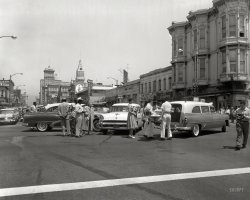
- Double Feature: 1950
- ... this be older? Both movies shown in reverse are from 1937 and Victrolas were last sold in 1929. I wish there was a car or something ... Posted by Dave - 04/29/2014 - 2:28pm -
![Double Feature: 1950 UPDATE: More Waffle Shop here and here.
Washington, D.C., circa 1950. "Waffle Shop on 10th Street. Exterior from side angle, day. For Bernard L. Fishman." Photo of the now-defunct eatery, shortly after it opened, by Theodor Horydczak. View full size.
Re: Could this be older?Note date on trim high above entrance: 9-11-50.
Could this be older?Both movies shown in reverse are from 1937 and Victrolas were last sold in 1929. I wish there was a car or something to show this as newer.
[The Waffle House opened in 1950, so it can't be older than that. The Victor and Victrola brands were used on phonographs made by RCA into the 1970s. The double bill of San Quentin and Alcatraz Island played at the Metropolitan in October 1950. And there is a car in the photo! - Dave]
Prison DramaOld-school.
After my waffleYou'll surely find me next door, at "The House of 1,000 Tools".
Across the street from Ford's TheaterI ate lunch there at least a hundred times in the late '50s to early '60s and never had waffles (it was also a burger joint). This original Waffle Shop closed in 2007 and the deteriorating facade was still there years later. Some of the iconic interior fixtures were saved, and Waffle Shop version 2 recently opened a few doors down the street.
Mystery number on marqueeThat's the permit number for the sign projecting into public space. DC construction code still says today: "Marking of signs. Every sign for which a permit is required shall be marked with letters not less than 1 inch (25.4 mm) in height, giving the permit number and date of permit issuance (DCMR12, Section 3107.5).
Nice of Waffle Shop to so precisely follow the regs. The building was built in 1950.
The business is still there, two doors downI don't know what actually led them to leave the awesome deco-licious Waffle Shop space, but the business is still in existence a few doors down in a much less photogenic space. It's still one of the few breakfast joints in that area, however.
I learn something new every day.Now I know that the plural of Victrola is Victrola.
I love the font, ( or should that be script? ), used for the sign 'Waffle Shop'. Very elegant, and stylistically extremely appropriate.
Hanging OnOnly the S survives. The Help Shop "popup store" in 2012.
(The Gallery, D.C., Eateries & Bars, Movies, Theodor Horydczak)](https://www.shorpy.com/files/images/SHORPY_13317u.thumbnail.jpg)
- The Device: 1938
- ... it at a conference on "fever therapy" in New York in 1937. Water at 130 degrees is sprayed on the patient in such fine droplets ... Posted by Dave - 04/28/2015 - 9:16am -
![The Device: 1938 Washington, D.C., 1938. "Marie Passapae, C. Coy Honsaker" is all it says here. Are there enough clues to tell us what's going on? 4x5 glass negative. View full size.
Details.The nameplate.
Honsaker Sauna CabinOr cabinet.
Iron LungEarly prototype.
[At first glance. But iron lungs aren't top-loading. - Dave]
Spa TreatmentShe's lying on a towel from the Willard Hotel in Washington, DC.
The towel and fan and neck seal suggest some spa treatment.
Apparatus for and method of inducing pyrexiaLooks like it was patented by Charles C. Honsaker:
http://www.google.com/patents/US2203263
"This invention relates generally to the art of "hydrotherapeutics and more particularly to an apparatus for and method of inducing pyrexia in the treatment of various diseases and disorders of the body."
Hot Fog BoxThat's what the inventor, Mr. Honsaker, called it when he exhibited it at a conference on "fever therapy" in New York in 1937. Water at 130 degrees is sprayed on the patient in such fine droplets "that it feels like the sensation of drifting fog," claimed Mr. Honsaker.
SleekPretty nifty, sleek design, and notice the pinstriping too! Someone took pride in their work!
Hot FlashRaising body temperature was an accepted treatment for syphilis before the discovery of penicillin. Typical article from the Western Journal of Medicine, March 1934:
(Technology, The Gallery, D.C., Harris + Ewing, Medicine)](https://www.shorpy.com/files/images/SHORPY-25247a.thumbnail.jpg)
- Grande Stand: 1946
- ... full size.
Pocket Book x 2 Trial and Error (1937) by Anthony Berkeley (1893-1971) and The Bellamy Trial (1927) by ... Posted by Dave - 02/06/2015 - 9:40pm -
![Grande Stand: 1946 New York, 1946. "Garcia Grande newsstand." With the freshest issues of FLIP, NIFTY and LAFF. 4x5 acetate negative by John M. Fox. View full size.
Pocket Book x 2Trial and Error (1937) by Anthony Berkeley (1893-1971) and The Bellamy Trial (1927) by Frances Noyes Hart (1890-1943).
A study in retailDour clerk has no customers, Cheerful clerk racking up the sales.
We can officially change the "Circe 1950" to 1946this issue of "Zoo Funnies" (That is hanging over the counter) is listed as Feb. 1946.
[That tricky word is "circa." - Dave]
ChallengeLooks like another challenge for the person who colorized the last newsstand photo.
Newsstand LocationI don't see enough clues to make a determination as to where this newsstand was located in Manhattan. Perhaps Grand Central Terminal, based on the name "Grande"? Perhaps Rockefeller Center? Maybe the lobby of a large building?
["Garcia Grande" is a cigar. - Dave]
And who wouldn'tbuy a magazine titled "NIFTY" ?
Presidential newsstandIs that LBJ in the dark suit behind the counter?
The latest issue of EbonyHowever, Jet weekly is still about a year away.
Flip not very freshIf this is truly 1950 then that edition of flip is a back issue.
It's listed on a couple eBay auctions as 1946 Issue #1
The hair of the woman on the cover looks more like 1946 than 1950.
[Evidently it's time for our annual refresher course on what "circa" means. - Dave]
(The Gallery, John M. Fox, NYC)](https://www.shorpy.com/files/images/SHORPY-220-02.thumbnail.jpg)
- Tire Service: 1942
- ... there.
Here is an earlier image, probably taken in 1937.
(The Gallery, Cars, Trucks, Buses, Los Angeles, Russell Lee) ... Posted by Dave - 09/01/2015 - 11:04am -
![Tire Service: 1942 1942. "Hollywood, California. Tire service station." Mosher Tire, next door to the Dix Hotel. Photo by Russell Lee for the Office of War Information. View full size.
TopperSomething older is parked at the curb to the right of the frame and it appears to have a So Cal AAA license plate topper attached to it!
DeluxeNice 1938 ford Deluxe Tudor sedan parked in front of the bargain rack. I have a '38 Standard Tudor...but not that nice.
Don't bump your head3rd floor room/special rate.
Draft registrationMr. Mosher would be registering for World War I not World War II. His age was 57 in 1942.
[Age requirement for WWII draft registration was 18-64. -tterrace]
I stand corrected. Thanks tterrace as I dropped the ball you picked it up.
MotorolaMotorola was the big name - if not the only one - in auto radios at that time. The company had a large stock of auto radios at the war's beginning. Since auto manufacturing was suspended for the duration of the war, Motorola sold "chairside" radios, which were auto radios converted to 110-volt AC power and installed into end tables.
Rubber RoomsToo bad the tiny top floor room doesn't provide a view of all those luscious, war-rationed tires.
Still going in 1968... according this post in a forum discussion. It says:
"The founder of Mosher Tire Service was Lewis Dean Mosher, born in Illinois on September 26, 1885. His obituary says he was a pioneer in North Hollywood beginning in 1927 and that he had founded his tire business in Los Angeles in 1905 . . . When he filled out a draft registration for WWII he . . . lists his business address as 1534 N. Cahuenga Bl, North Hollywood."
Ah, those daysWhen a half a dozen sizes fit ALL cars. Today, it seems tire shops must have hundreds of sizes, let alone brands.
Part of my family history!This is where my grandfather, Lewis Dean Mosher worked. Later in 1942 the business moved to 12117 Burbank Blvd in North Hollywood. My father and my uncle ended up working together with my grandfather for some time. Eventually my dad, Merrill D. Mosher operated it until he retired. The original structure on Burbank Blvd is no longer there, but the house next door, where my grandparents lived starting in 1927, is still there.
Here is an earlier image, probably taken in 1937.
(The Gallery, Cars, Trucks, Buses, Los Angeles, Russell Lee)](https://www.shorpy.com/files/images/SHORPY-8d28160a.thumbnail.jpg)
- Bumper Buddies: 1940
- ...
Two different truck years The guys are sitting on a 1937 Chevrolet Half-Ton pickup. What's throwing me off is the position of the ... Posted by Dave - 07/30/2019 - 5:26pm -
![Bumper Buddies: 1940 December 1940. "Camp Livingston, Alexandria, Louisiana. Construction workers from Monroe sitting on car in front of their shacks before leaving for evening shift." Medium format negative by Marion Post Wolcott for the Farm Security Administration. View full size.
Here's looking at me, kid.Bogie on the fender.
Pitching a TintAnyone colorizing this? The 1940 Louisiana license plate featured beautiful dark blue characters on brilliant orange background, a striking contrast. And yes, that is a little map of the state inserted between the banks of digits.
You can leave your hat onThat was an easy car quiz. The pickup truck is a mere 1941 Chevrolet AK 3104.
His new pickupJudging by the hood vents and cab, the truck is a brand new 1941 Chevrolet Series AK pickup. 1941 was the first model year for the AK, which was replaced by the Advance Design trucks in June 1947.
Two different truck yearsThe guys are sitting on a 1937 Chevrolet Half-Ton pickup. What's throwing me off is the position of the wipers -- they ought to be on the top of the windshield frame, not the bottom. The truck to the left appears to be a 1941 Chevrolet Half-Ton. Both are classics!
[That thar is a car. - Dave]
(The Gallery, Cars, Trucks, Buses, M.P. Wolcott)](https://www.shorpy.com/files/images/SHORPY-8c14287a.thumbnail.jpg)
- Uneasy Rider: 1931
- ... 64% in 1932. Auburn production finally ended in August of 1937. The rights, tooling, castings, etc. for the V-12 engine Auburn brought ... Posted by Dave - 07/12/2016 - 12:57pm -
![Uneasy Rider: 1931 San Francisco, 1931. "Auburn at Golden Gate Park." Similar to the car seen earlier here. 5x7 inch glass negative by Christopher Helin. View full size.
OffhandedHe should have had the stitches holding his pocket closed removed before he posed for the picture. He would then have been able to get his whole hand into it!
WorrywartThe guy looks a lot like Bob Crosby on a bad day.
Similar, but DifferentThe earlier Auburn is a sedan with a canvas covered roof. This one's a convertible.
[So it is! I thought they had the same tag number, but not quite. -Dave]
Not an easy clean.Imagine crawling underneath That Auburn to scrub those B.F. Goodrich double whites.
Serial NumbersNote that they are both dealer plates. I'd be happy with either car today.
That gentleman needs a shoeshineThen there would be a smile in his heart--even if the scowl on his visage remained the same.
Knockoff HubsWheels, use a hammer to spin the hub cover. If you look carefully, you can see the arrows on the front wheels hubs that indicate which direction they spin. Auburn was quite sporty. This example is interesting in how the height of the windscreen is used to make car look bigger.
HubcapsHow did they get them off. They are only flat on one side to pound them on/ tighten them. You would have to hit on an angle to loosen them.
Auburns looked so great!Like many teens of my generation, I first became aware of Auburns and Cords when Olds introed the Toronado, which hit me (as Nicky-Nick-Nick would say) "Like the hot kiss at the end of a wet fist."
My wife and I are shopping right now for what will likely be our last new car, and they all look like bars of soap.
Re: Knockoff HubsYou used the hammer on the flat side of the 'wings' to loosen the hub (hence, 'knockoff'); the threads on the hub tightened with the rotation of the wheels when the car was moving forward, so the hubs only needed to be hand tightened, with maybe a love tap or two from the hammer. The hammer, incidentally, was wood or leather, to avoid damaging the hubs.
Re: Re: Knockoff HubsBack in the day I owned a 1962 MGA 1600 MkII equipped with wire wheels with knockoff hubs. Rather than wood or leather, the mallet had a solid copper head to avoid damaging the hubs. Wish I had that car today.
HeterogeneityNot readily visible in the photo are the contrasting colors that were in vogue on the 1931 Auburns. The photos below provide much more vivid illustrations of the blatant color schemes available. One of the people assisting the design staff was Count Alexis de Sakhnoffsky who was known for his use of extravagant color schemes. He was, at the same time, also the body designer of the more subtlety colored DeVaux cars seen here.
The Auburn shown is a model 8-98A Custom Phaeton Sedan which cost $1,345 and weighed 3,700 pounds. The freshly styled Auburns were three inches lower than the previous year which was possible by the use of underslung semi-elliptic springs and 17 inch wheels. The bumper with the drop in the center was a covert allusion to the reduced height of all Auburn models. The windshield on this model could fold down over the cowl. Safety glass was optionally available, but radios from the factory were still not offered.
This was Auburn's best year for sales with 32,301 cars produced, and the firm rose from 22nd place in the industry in overall sales to 13th place. It was the only time Auburn broke into the top 20 of U.S. automobile manufacturers. Sales would fall more than 64% in 1932. Auburn production finally ended in August of 1937. The rights, tooling, castings, etc. for the V-12 engine Auburn brought out in 1932 were purchased by American LaFrance, improved, and then utilized in their smaller fire trucks until 1963.
(The Gallery, Cars, Trucks, Buses, Chris Helin, San Francisco)](https://www.shorpy.com/files/images/SHORPY-1005.thumbnail.jpg)
- Roney Plaza: 1939
- ... Arts architecture and up-to-the-minute 1939 1938 1937 Buick.
Missed It By That Much That '39 Buick is actually a '37.
... Posted by Dave - 05/01/2019 - 9:50pm -
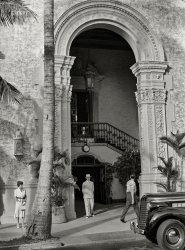
- Aerial Omaha: 1938
- ... was an apartment building offered for sale in January 1937. Directly across the street from it was the “Hummel Auto Shed” and ... Posted by Dave - 09/14/2017 - 9:05pm -
![Aerial Omaha: 1938 UPDATE: Our vantage point for this view north along 14th Street is the Woodmen of the World tower at 1323 Farnam.
November 1938. "Omaha, Nebraska." Gateway to the West. Medium format negative by John Vachon for the Farm Security Administration. View full size.
FansAnyone aware of what the contraption is on top of the building on the left. I see fan units. Was this an air conditioning system? If so it is very narrow.
Three Corner TavernsInteresting to note the small corner taverns in the Omaha photographs: in the “Omaha Suds” image, in the Theodore's Place image, and the Oaks Tavern in this image. Three corner taverns, each about the same size and height, although some more decorated than the other. I wonder how many others existed?
Across the street is the Paris Bar and Billiards. Oaks and Paris advertised together.
What Depression?For a small city during the worst of the later Depression years, this photo portrays an impressive proportion of late model vehicles. As opposed to the trucks, the great majority of the cars seen here are within 3 or 4 years of age if not newer -- a mix probably not excelled in most U.S. localities today.
Brand new Ford TudorThe car almost directly in front of the "Nebraska" is a new 1938 Standard Ford V8. I've had one of these since the late 1970's. Once considered the ugly duckling of the 30's by almost everyone is now kinda good looking. Kinda.
Scorch marksSo what was the commercial establishment that burned at the corner of 14th and Capitol? Whatever it might have been, the fire appears to have thoroughly gutted the place.
Pay no attentionI'm assuming that this picture was taken from an airplane, so it's interesting that none of the many people on the street are looking up at the photographer. It seems like an airplane flying low over the downtown area would attract a lot of attention!
[The photo was taken from the Woodmen of the World building at 1323 Farnam Street. - Dave]
Gateway to the WestJust a minute, that nickname belongs to my native city, Winnipeg, Manitoba. But wait, Wikipedia points out that it also refers to no fewer than 6 cities in the US (Fargo, Fort Wayne, Omaha, St. Louis and the Gateway Arch, Kansas City, Pittsburgh) and one whole state (Oklahoma, although particularly Tulsa).
Location, Location, Location?I believe this photo was taken from a building on the southeast corner of 14th and Farnam. In an aerial photo from the early 1950s I can see a tall building located at that corner.
Furthermore, in that aerial photo I can clearly see the Hotel Fontenelle a few blocks to the west at 1806 Douglas and I can positively identify the fronts of the buildings in the 1300 block of Douglas where Palace Billiards and the Oaks Bar were.
[You are correct about the location (my first guess, the Hotel Fontenelle, is on the wrong block). Which means our vantage point is the 19-story Woodmen of the World headquarters, at the time of its completion in 1912 the tallest building between Chicago and the West Coast. - Dave]
No Apartments AvailableThe three story brick building being demolished was an apartment building offered for sale in January 1937. Directly across the street from it was the “Hummel Auto Shed” and the Omaha World Herald delivery truck garage and parking lot and the vacant space diagonally across the street was the site of the Jefferson Hotel, demolished in 1935.
Win some, lose someBetween the Oaks Bar and the Nebraska theater is a campaign office with banners for 19938 candidacies of (James T.) English for (Douglas) County Attorney, and (Frank) McGrath for (Douglas County) Clerk of Court. English won, and later became a state-court judge. McGrath, an incumbent mired in scandals, lost.
(The Gallery, John Vachon, Omaha, Railroads)](https://www.shorpy.com/files/images/SHORPY-8b14207a.thumbnail.jpg)
- Rust Belt Riviera: 1941
- ... for the FSA. View full size.
High Water In 1937 there was a devastating flood. So my guess is that there is not a whole ... Posted by Dave - 11/06/2019 - 1:36pm -
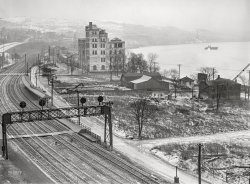
- Here's Lucy: 1908
- ... on the Allegheny River at 51st St, it was dismantled in 1937.
The Romance of Steel, 1907.
By Herbert N. Casson
... Posted by Dave - 08/09/2012 - 2:42pm -
![Here's Lucy: 1908 Pittsburgh circa 1908. "Carnegie Steel Company, 'Lucy' furnace." 8x10 inch dry plate glass negative, Detroit Publishing Company. View full size.
Recycle 1908 styleThat is a very up-to-date string of coal cars in the background. All steel cars show Keystone Coal to be a very modern operation.
In the foreground is several stretches of disconnected narrow gauge plant track, with a string of cars and wheelsets nearby. These plantracks would change location quickly, as needed.
But what really interests me is that arch-roof former baggage car lettered American Bridge of NY. That car could easily be forty years old here.It likely was used by AB to carry rigging and supplies for their projects, although it may no longer be in use. To its right is a short ex reefer. [The hinged doors give away its former occupation. The windows cut into it indicate other uses by ABNY.] Its odd, double archbar trucks were popular on New York Central lines for a time.
Broken WindowsWell, I guess bridges shouldn't have windows, anyway.
The tradition at U.S. SteelThe tradition at U.S. Steel is to name furnaces after wives of the President/Chairman. Lucy Coleman Carnegie was wife of Thomas M. Carnegie.
Where was Pittsburgh, anyhow?The Lucy Furnace was named in honor of Andrew Carnegie's sister-in-law, Lucy Carnegie. Located on the Allegheny River at 51st St, it was dismantled in 1937.
The Romance of Steel, 1907.
By Herbert N. Casson
The Rise of Andrew Carnegie
… In 1873 two new furnaces had been built, now famous in the iron world as the Lucy and the Isabella. The Lucy belonged to the Carnegie company, and the Isabella to a combine of Pittsburgh iron men. These furnaces were of equal size, and belonged to rival owners. They began at once to race in the production of iron, and their amazing achievements for the first time attracted the attention of all countries to Pittsburgh.
The average output of a furnace was then fifty tons a day. There were wild hurrahs at the Carnegie company's works in 1874, when, for the first time in the history of ironmaking, the Lucy turned out a hundred tons of iron in one day. In England the news was received in silent incredulity. To believe that a single furnace could pour out twenty-two thousand dollars' worth of iron in a week was too much. Where was Pittsburgh, anyhow? And who was this Carnegie who made such preposterous claims? …
A second Lucy furnace was built in 1877, and the Carnegie company operated both until the organisation of the Steel Trust. During that period of nearly thirty years they produced more than three million tons of iron—enough to give four pounds apiece to every man, woman, and child on the globe; enough to pave a road seventy feet wide with iron plates an inch thick from New York to St. Louis. …
There is nothing idyllic about the Lucy furnaces. They have received no honours, no medals, no monuments. They have inspired neither artist nor poet. Yet for thirty-three years, for every hour of the day and night, they have been untiringly making the useless into the useful, magically transforming the ore into a ceaseless stream of that metal which is immeasurably more precious to civilisation than all the gold and silver and rubies and diamonds.
(The Gallery, DPC, Factories, Pittsburgh, Railroads)](https://www.shorpy.com/files/images/SHORPY_4a19413a.thumbnail.jpg)
- The Annex: 1940
- ... unknowns...the sedan moving away on the right is a 1937 Dodge.
space Jim Dandy, not sure what you are seeing as wasted ... tall.
The Unknowns The forward unknown car is a 1937 Oldsmobile Series F (I think. High-mounted, bullet-shaped tail lights, ... Posted by Dave - 09/24/2017 - 7:00pm -
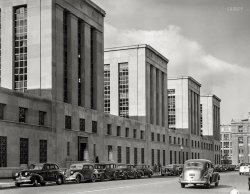
- Reliable Shoe House: 1920
- ... store was destroyed by a five-alarm fire on December 12, 1937.
Luther Reason Ray I found a design by architect Luther Ray while ... Posted by Dave - 09/03/2012 - 11:52am -
![Reliable Shoe House: 1920 Washington, D.C., circa 1920. Hahn's shoe store at Seventh and K streets N.W. View full size. National Photo Company Collection glass negative.
Hahn'sThe building still exists, and the shoe store closed only about 10-12 years ago. I used to buy all my shoes there, including my first grown-up shoes for my first job, for a law firm across the street.
That is neatI would give my bottom dollar to have seen what new-old-stock they had available when they closed down. Size 8 please...
Hahn Shoes: 1891 The Washington Post, Oct 13, 1891
William Hahn & Co. Formally Open Their New Establishment
William Hahn & Co. celebrated the occupation of their new place of business at 930 and 932 Seventh street yesterday and last night be a formal opening, that was attended by great crowds of people. The new building, which was demanded by the increasing trade of the firm, was built expressly for them. It is a beautiful structure, three stories high, and every available foot of space is devoted to the large assortment of goods handled by the firm. The fixtures are of oak, and the office cashier's box, and wrapping counter in the front of the main salesroom are an innovation on the usual methods of construction. The fixtures, for both gas and electricity, are black and form a pleasing contrast to the thousands of white boxes containing shoes. ...
Hahn Shoe DCThe corner occupied by Hahn is the SW corner of Seventh Street and Massachusetts Avenue NW. K Street goes west to Seventh and stops at Mount Vernon Square, where Carnegie City Library was built. K restarts west of Ninth Street all the way to Georgetown.
[This is Seventh and K, not Seventh and Mass. - Dave]
Hahn'sHahn shoes ware the best. Someone should start a Facebook for all Hahn's-related stuff.
You Are HereThe address is also in the medallion on the corner of the building.
The old hotfootHahn's shoe store was destroyed by a five-alarm fire on December 12, 1937.
Luther Reason RayI found a design by architect Luther Ray while researching him in the Library of Congress archives. It appears to have been either a plan for a remodel of a this building or one for a replacement. Do we know if it was ever built?
(The Gallery, D.C., Natl Photo, Stores & Markets)](https://www.shorpy.com/files/images/30556u_0.thumbnail.jpg)
- Church of the Nativity: 1940
- ... stylish among British women of a certain age between about 1937 and 1940.
(Referring to the late Queen Mother, of course, who became ... Posted by Dave - 12/16/2007 - 8:05am -
![Church of the Nativity: 1940 Christmas in the Church of the Nativity at Bethlehem circa 1940. View full size. 4x5 glass-plate negative, G. Eric and Edith Matson Photograph Collection.
So, what are those?What are the things hanging in the picture? Incense?
[Answer above. - Dave]
So, what are those?The hanging things are oil lamps, not censers. Just above the lamps themselves are oval ostrich eggs -- a symbol of hope and the Resurrection. The lamps are lowered during the day to be refilled and have their wicks trimmed. Orthodox churches in Jerusalem and elsewhere have dozens of these lamps, many of them donated over the centuries by Christian pilgrims.
[Thank you! - Dave]
DateJudging by the western ladies hats the date would be more like 1928-1930 I think.
[It's not. - Dave]
HatsThat's a Queen Elizabeth Hat, very stylish among British women of a certain age between about 1937 and 1940.
(Referring to the late Queen Mother, of course, who became Queen Consort at the end of 1936.)
I'm sorryBut Anonymous Tipster is right, all the ladies clothes date from between 1928 and 1930.
[The dating comes from the photographer's logbook. -tterrace]
(The Gallery, Christmas, Matson)](https://www.shorpy.com/files/images/00660u.thumbnail.jpg)
- Parked for the Duration: 1942
- ... Chevrolet; 1940 Oldsmobile; 1941 Dodge; 1938 Plymouth; 1937 Ford; 1938 Buick; 1941 Oldsmobile; and a 1939 Buick.
No SUVs or ... Posted by Dave - 10/22/2014 - 9:55am -
![Parked for the Duration: 1942 1942. "Effect of gasoline shortage in Washington, D.C." Medium format nitrate negative by Albert Freeman for the Office of War Information. View full size.
WhereaboutsThis is the 1400 block of New York Avenue NW, looking north. Behind the lot are the rear of the buildings fronting on H St. These include 1416 H St. NW & its distinctive rounded bay, seen below in the 1921 Baist Atlas.
At center top, note the back (eastern facade) of the Southern Building, 805 15th St. NW.
Spotter's Dream Come True!Who going to name all the cars in this photo?
The Trans-Lux TheatreThe "Theatre Exit, do not block" sign is for the Trans-Lux.. The Trans-Lux was at 14th and H Streets NW the screen end of the auditorium was behind the pictured doors. The Trans-Lux was torn down in 1974.
ProgressIt is interesting to note how few years separate the little '32 Chevy from the rest of the modern iron in the lot. It still has styling cues from the twenties. All the rest have streamlined bodies, pontoon fenders, big, powerful engines and so on. The late 30's was a period of huge automotive advances
My Kind Of PictureAwnings and old cars.
Spotted for the DurationI recognize a number of the cars in the lot, numerous Buicks, Oldsmobiles, Fords, Dodges, etc., but for now I'll just highlight that 1938 Lincoln Zephyr front and center in the parallel-parked row. It could stand a wash, but meanwhile reminds me of the similar 1941 Zephyr 4-door fastback my family drove during my earliest years. That car's wonderful streamlining has determined my aesthetic toward automobiles (and pretty much everything else) ever since then.
Parking feesI know I am from a different age and country for that matter, but are the parking fees a little expensive for that time?
I am drooling...I wish I could select even one of those beauties.. ok, let's say two! American cars made around 1940 really appeal my eye. They simply look like cars.
Parked for 9 or 10 Hours?I think these cars have only been parked for the work day. Too many of them have open windows to have been parked for the duration of WWII. Along with many open door vent windows there are several cars with open hood vents that surely would have been closed if this was a long-term storage lot. The location, in the heart of D.C., also seems like a strange place to locate a place to store cars for a lengthy period of time. I think the photographer's caption is erroneous or someone else mislabeled the photo.
[The caption comes from the LOC catalog card for a collection of negatives mainly depicting parked cars in a variety of situations about Washington, D.C. -tterrace]
The car parked front and center is actually a 1938 Lincoln-Zephyr, not a 1941 model. The two most easily identifying features are the comet tail trim on the side of the hood and the exposed running boards. In 1939, all the way through the 1942 model year when the last Lincoln-Zephyr was built, the running boards were concealed by the doors on Lincoln-Zephyrs. The Zephyr name was dropped when Lincoln production resumed after WWII, but the same basic models continued in production.
Parked in front of the Lincoln-Zephyr is a 1941 Plymouth, and parked behind it is a 1941 Hudson Commodore Eight.
From left to right, parked in the front row, are these cars: 1941 Chrysler; 1936 Plymouth; 1932 Chevrolet; 1940 Oldsmobile; 1941 Dodge; 1938 Plymouth; 1937 Ford; 1938 Buick; 1941 Oldsmobile; and a 1939 Buick.
No SUVs or trucks are in the lot, but there is one 1938 Ford Station Wagon, Type 790, behind the 1939 Buick. The Station Wagon was marketed as a passenger car for the first time, but also continued to be sold as a commercial model. To lighten the tailgate the spare tire was stored inside the vehicle behind the driver's seat.
(The Gallery, Albert Freeman, Cars, Trucks, Buses, D.C., WW2)](https://www.shorpy.com/files/images/SHORPY-8d36716a.thumbnail.jpg)
- Baby Vegetables: 1940
- ... the ground!
1940? The calendar on the wall reads "1937."
[Being used for decor. Below, a shot a few frames away on the same ... Posted by Dave - 08/01/2012 - 4:54am -
![Baby Vegetables: 1940 July 1940. "Canning beans in farm kitchen near Bristol, Vermont." Photo by Louise Rosskam for the Farm Security Administration. View full size.
All growed up - and then someOur cheerful baby would now be 73 years old. It would be nice to see a photo of her (him?) today. Google People View?
Old things!Oilcloth and enamel pots and pans. Two neat old things you just don't see anymore.
May I join you?This is one of those pictures I sure wish I could walk into and join the action! It brings back lots of memories of canning various fruits and veggies, with my mother-in-law, sisters-in-law, and various friends. It's a big job, but a lot of fun, if there is good company, during it. Not much is so gratifying as seeing rows of filled jars, from the Summer and Fall bounty, knowing that one's family will benefit from it when there is snow on the ground!
1940?The calendar on the wall reads "1937."
[Being used for decor. Below, a shot a few frames away on the same roll. - tterrace]
BabyThat's about the most gleefully happy baby I've seen in one of these pictures. Must be thinking about eating those beans.
Let's see that calendarCan you zoom in on that calendar? It almost looks like it says "C. A. Donah" on it.
[Alas, it's not clear on the the full-size original. - tterrace]
Well-ShodMom and Grandma wearing some nifty shoes.
(The Gallery, Kids, Kitchens etc., Louise Rosskam)](https://www.shorpy.com/files/images/SHORPY_8b30802a.thumbnail.jpg)
- M.I.T.: 1901
- ... in use as the School of Architecture into the 1930s. In 1937 it was purchased by the New England Mutual Life Insurance Company and ... Posted by Dave - 07/30/2012 - 4:37pm -
![M.I.T.: 1901 Boston circa 1901. "Massachusetts Institute of Technology, Rogers Building." 8x10 inch dry plate glass negative, Detroit Publishing Company. View full size.
Check outCheck out the nearly-identical image.
[A Detroit Publishing Co. postcard]
Man in frontHe's just scratching his eye. Really.
1866 - 1939MIT's First Building, 95 feet wide by 140 feet long, consisting of five stories and one half story.
Biological Laboratory
In 1883, one year after the death of William Barton Rogers, the MIT Corporation voted to name the facility “The Rogers Building.” Already, however, the Institute had started to outgrow the building. By the early twentieth century MIT had spread to a dozen or so buildings in the Copley Square area and the need for more space was obvious, foreshadowing the Institute’s 1916 move of most operations to the current Cambridge campus. The old Rogers Building continued in use as the School of Architecture into the 1930s. In 1937 it was purchased by the New England Mutual Life Insurance Company and razed in 1939 to make way for their new home office.
M.I.T.'s first building. More on The Rogers Building.
Cambridge?That would be Cambridge, not Boston, no?
[Prior to 1916, M.I.T. was located in Boston.]
BreezersInteresting how many photos of cities in the temperate zone show those open-air streetcars or "breezers," as they're sometimes called. Wonder what they did in winter time. Did they put them away and bring out more of the enclosed cars? That would sure require an extensive overall fleet investment. I've enjoyed riding on breezers at an Iowa location, and they don't look like they could be fitted with any kind of enclosing protection.
(The Gallery, Boston, DPC, Horses, Streetcars)](https://www.shorpy.com/files/images/SHORPY_4a07478a.thumbnail.jpg)
- Real Simple: 1936
- ... from 1934 to 1938. The first families moved in in October 1937.
This picture claims to have been taken in November 1936, 11 months ... Posted by Dave - 02/05/2013 - 10:54am -
![Real Simple: 1936 November 1936. "Interior of house. Greenbelt, Maryland." One of three planned "Green-" communities midwifed by the Resettlement Administration during the Great Depression. Luxe amenities included indoor plumbing and electricity. Medium-format nitrate negative by Arthur Rothstein. View full size.
Don't blow a Fuse!I first noticed the cover off of the fuse box just to the left of the distant door, then... a fuse laying below on the floor? I wonder what that's all about? Every Shorpy photo has a back-story to tell, or a riddle to solve!
Today?My Dad has lived in Greenbelt for 40 years. He says he will never move. He loves the small town feel, and the planning that went into the community. PG County is a rough area in general, but Greenbelt has the old town feel even today. Besides, He is right across the street from the police station.
Probably a spareI'll bet the fuse on the floor is ready for replacing the next one that blows out. Our fuse box hung on the basement wall, so we put extra fuses on top of it, because they'd need replacing probably twice a week or so. It didn't take much to exceed capacity. I was probably seven when I was taught to replace them.
We had friends who used pennies instead of fuses, to save money. It's not an old urban legend, it really happened!
Old Fashioned Window BlindsFor those as old or older than me, remember tugging on them a little more than was necessary and it would go flap flap flap all the way to the top scaring the bejeesus out of you? There was a real skill in pulling them down or up to the desired position.
[Yeah, exept we called them shades, not blinds. - tterrace]
About that fuse.I would bet that the photographer's lights are taxing the limited power supply and they've already swapped out a 15 amp for a 20 or 30. Just a guess.
StagedGreenbelt was constructed from 1934 to 1938. The first families moved in in October 1937.
This picture claims to have been taken in November 1936, 11 months before the community opened. It was likely staged and taken for the promotion of the community by the Resettlement Administration. The house may not have been completely finished yet, and that may explain the fuse issues.
Zen kitchenOr maybe it's kitchen by Ingmar Bergman. Either way, it's a bit austere, but certainly not without its charms.
Re: Probably a spareI remember the extra fuses sitting just inside the fuse box at home, while growing up. I also remember stories of friends and neighbors using the pennies in the place of a fuse; and a few of them actually survived the house fire to tell about it.
Gotta love EbenezerRexford Tugwell, the designer of Greenbelt Md, got his inspiration for Greenbelt, MD. from the esteemed Sir Ebenezer Howard. Howard was the first to plan Garden Cities, which Greenbelt, Md. is derived. It's too bad that future federal efforts at housing abandoned this idea and instead utilized ugly, almost Soviet Bloc styles of construction. Garden cities are wonderful. We need many more of them.
(The Gallery, Arthur Rothstein, Kitchens etc.)](https://www.shorpy.com/files/images/SHORPY_8b28403a.thumbnail.jpg)
- The People's Favorite: 1917
- ... go elsewhere.
The Reason for the March Date Until 1937 Inaugurations were always held on March 4, unless it was a Sunday. From 1937 on the date has been our traditional January 20 (unless it's a Sunday, in ... Posted by Dave - 03/09/2017 - 1:29pm -
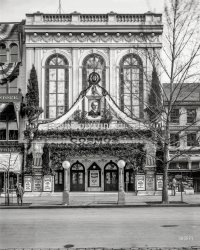
- New York, New York: 1941
- ... with my mother. We sailed on the 23rd of December 1937, Cabin 320, second class. The ship stopped overnight on Ellis Island to ... Posted by Dave - 09/09/2011 - 7:29pm -
![New York, New York: 1941 December 1941. "Lower Manhattan seen from the S.S. Coamo leaving New York." View full size. 35mm negative by Jack Delano. Office of War Information.
Sinking of the CoamoSS COAMO (December 9, 1942)
US freighter of 7,057 tons, built in 1925 for the Agwilines of New York. The vessel was en route from Gibraltar to New York when it simply disappeared without trace. It was later discovered that the ship had been torpedoed by the German U-boat the U-604. The Coamo was carrying 186 persons including the crew. The entire merchant marine crew of 133 men plus 37 Armed Guards and 16 Army personnel were lost, in this, the greatest tragedy to befall a single crew on a US Merchant Marine ship in WWII.
Interesting account and pictures here.
[Fascinating. And tragic. On a related note, the Coamo rescued 71 people from the Canadian liner Lady Hawkins after it was torpedoed and sunk by a U-boat in January 1942, with the loss of some 250 lives. In our photo, the ship is departing New York for Puerto Rico (it was named after the city of Coamo there), where Jack Delano took hundreds of photographs on assignment for the Farm Security Administration. He liked the island so much that he made his home there after the war. Three of his shipboard photos are dated November 1941; December 1941 is the LOC's "published/created" date, so it's hard to say exactly when this was taken. - Dave]
From Puerto Rico to New YorkI arrived in New York City on the Coamo. The ship was part of the Bull Lines, or the Porto Rico Line. I was 7 years old, traveling with my mother. We sailed on the 23rd of December 1937, Cabin 320, second class. The ship stopped overnight on Ellis Island to disembark immigrants from Europe and South America. The trip was uneventful, although I was seasick. I never thought I would see a picture of the Coamo. I do know that Mr. Delano lived in P.R.
(The Gallery, Boats & Bridges, Jack Delano, NYC)](https://www.shorpy.com/files/images/8a37402u1.thumbnail.jpg)
- Product Placement: 1938
- ... Tjaarda was (again, if I am correct) responsible for the 1937 Lincoln Zephyr which strongly influenced the "look" you see here.
My ... Posted by Dave - 07/24/2012 - 9:49pm -
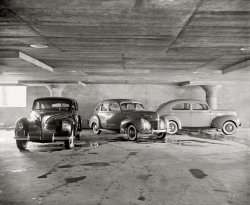
- Fiesta Class: 1930s
- ... that transition. I would place this picture around 1936 or 1937 by the hairstyles, and I see nothing in the clothes to contradict that. ... Posted by Tony W. - 10/08/2011 - 4:28pm -
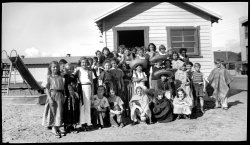
- Re-Tirement Home: 1940
- ... full size.
Carbonated Coke It seems that this 1937 Ford sedan's flathead V8 is getting a de-coke job. The engine ... Posted by Dave - 06/19/2018 - 10:17pm -
![Re-Tirement Home: 1940 March 1940. "Secondhand tires displayed for sale at service station in San Marcos, Texas." A leading candidate for the first Krispy Kreme franchise. Medium format negative by Russell Lee for the Farm Security Administration. View full size.
Carbonated CokeIt seems that this 1937 Ford sedan's flathead V8 is getting a de-coke job. The engine compartment's side panel has been removed for access and is resting against the Ford tire rims along the wall, with a new head gasket lying on it. The cylinder head has been removed and the gent who is just visible behind the right side of the car is scraping the carbon that has built up inside the head's combustion chambers (called decoking or decarbonizing). This was a common procedure on older cars, given their low compression and the poor quality of fuels. Buildup of carbon (coke) led to a drop in engine performance, so it had to be cleared out from time to time. Indeed many owner's manuals even had the procedure detailed for the owner to perform himself.
Why I follow ShorpyThe wonderful titles, hilarious takes like the "first Krispy Kreme franchise" in descriptions, and that the very first comment is a detailed explanation of what some guys working on a car 80 years ago were really doing.
Major repairsAt the time it was common practice to do engine overhauls, including the aforementioned carbon removal, cleaning out the oil pan and passage, and replacing the main bearings. In many cases, the main bearings were poured in place - the bearing material (babbit or something like it) would be melted and poured into place in the journals. This was something a good service station would do, maybe in less than as 50,000 miles.
This was before detergent oil, so crud would just fill it up eventually. I have seen cars from as late as the 60s where oily sludge had built up to the point that it filled up the engine, so you could take off a valve cover, and have a 6" deep layer of sludge in the shape of the interior of the valve covers, with small gaps where the oil was forced out of the passages.
Now it is normal and expected that an engine will run 200,000 miles with no internal failures or significant wear, and no real maintenance aside from oil changes. To the point that everything else in the car has been destroyed long before the engine goes bad. The "good old days" sucked, for the most part.
Wheeling in more ways than oneThe building is at least partially clad in Wheeling Corrugating Company's "Cop-R-Loy" steel, as we can see by the imprint above the side garage. This brand of sheet goods consisted of a mild steel with a small amount of copper added to reduce corrosion. It was quite popular and used in a great many water-contact steel products of that era. I still have a bucket in the garage with the same brand ... and still no rust!
It's 1939 and 1940The month is March, and the Model A coupe is wearing a 1940 license plate, while the '37 Ford sports a 1939 plate. Until 1975, vehicles in Texas had to get new plates every year, and drivers had from January through March to register. This usually meant long lines of procrastinators at county tax offices at the end of March each year.
Third row, second from leftand put it on my new-fangled Sinclair credit card.
Just off the squareWithout going to stand on the spot I can't be 100 percent positive, but I believe this station stood on West Fort Street, also known as Texas Highway 80, maybe half a block west of the courthouse. (Fort Street was later renamed Hopkins.) At the far left of the picture, one of the cornices of the Hays County Courthouse (still standing, now with a New Improved Historic Designation) is visible.
Sinclair Credit CardsI didn't know there were credit cards of any kind back in those days.
Sinclair Gas Credit CardThe card was not a credit card but a GAS CARD, that you pre-filled before a trip that you could use to pump gas at their stations. The research on Sinclair's Website only turned up data about the company here.
[Like the sign says, it's a credit card. You charged your gas, then the company mailed you a statement at the end of the month. Pre-filled cards had to wait for the computer era. - Dave]
[Ah! I stand corrected]
(The Gallery, Cars, Trucks, Buses, Gas Stations, Russell Lee)](https://www.shorpy.com/files/images/SHORPY-8b24221a.thumbnail.jpg)
- Are We There Yet?
- March 1937. "Four families, three of them related with 15 children, from the Dust ... Posted by Dave - 02/19/2013 - 12:04pm -
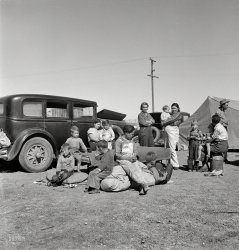
- Washington Pork: 1925
- ... absolutely delicious.
Thank You Sylvan Goldman In 1937 an Oklahoman named above dreamed up the first design for a shopping cart ... Posted by Dave - 08/05/2012 - 7:54pm -
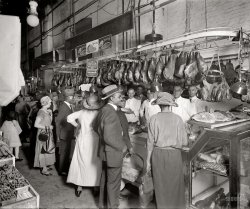
- Santa Fe Trailways: 1940
- ... Sailing Along https://www.allpar.com/history/plymouth/1937.html
Pie Town The vehicle appears to be a 1937 Plymouth DeLuxe seven-passenger sedan. For those who didn't know, the ... Posted by Dave - 06/15/2020 - 2:10pm -
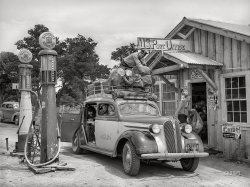
- Orphan Excursion: 1923
- ... worm or chain drive. The AB model was produced through 1937 (with coninuous modifications, of course), and over 55,000 were made ... Posted by Dave - 09/09/2011 - 1:41pm -
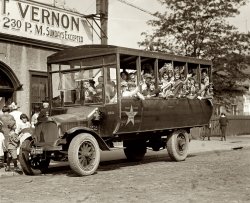
- Shirley Temple: 1928-2014
- ... styling there were 315 manufactured in 1938 (up from 50 in 1937). Sales fell rapidly with only 138 sold in 1939 and 61 in 1940. General ... Posted by Dave - 02/11/2014 - 9:30am -
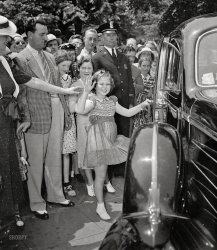
- Cabin in the Sky: 1940
- ... well.
Squeezed car I think it is a Plymouth, about 1937.
It's a 1938 Plymouth The car wedged between the '40 Buick and ... Posted by Dave - 10/08/2013 - 10:59am -
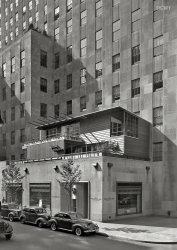
- Private Ambulance: 1927
- ... reward for the arrest and conviction of defacers.
In 1937, during Federal Trade Commission hearings on complaints about some of his ... Posted by Dave - 09/13/2011 - 2:02pm -
![Private Ambulance: 1927 Washington, D.C., circa 1927. "W.W. Chambers Co." An outside view of the funeral parlor at 1400 Chapin Street N.W. National Photo. View full size.
Progress1400 Chapin today. Lovely.
View Larger Map
Packard BellI will admit it, I have never seen a hearse with a fire bell on it. Here is your Packard hood ornament; they called them "mascots."
[Note that the lady on the ambulance lacks wings. - Dave]
For Whom the Bell TollsVery reminiscent of the type of ambulance Hemingway was in when he served in the American Red Cross in Italy in 1918 which gave him fodder for one of literatures greatest novels. Isn't it amazing what fueled some writers' imagination.
Hearse RaceIn the small town I grew up in, the local undertaker also provided the ambulance service. For years the owner of the funeral parlor also served as the local coroner. Perhaps now we would consider that a conflict of interest.
Ask the undertaker who owns onePackard aficionados will recognize the hood ornament as the "Goddess of Speed."
[She's more like the Aftermarket Knockoff Goddess -- no wings. The ambulance is a Cunningham. - Dave]
Nehemiah Shopping CenterThe strip mall in the Google Street View has been completely leveled. The plan is to put up an apartment building right out to the sidewalk, with street-level retail, which will be a big improvement.
Not a GlumbunnyThe following obituary is a real gem: from the story of "innovative" advertising techniques to the quote "Anyone can be a large undertaker in China."
The tale of W.W. Chambers' shockingly risque calendar, "Beautiful Bodies by Chambers," has crept into quite a few books about corpses and such. Alas, I have yet to find any images from the calendar on the internet.
Additional article and photos at findagrave.com. Also, a 1947 Time Magazine article which refers to the calendar controversy.
Washington Post, Apr 22, 1954
W.W. Chambers, Sr., Dies Unexpectedly
At 60 After Short Illness at Home
W.W. Chambers, Sr., 60, colorful Washington undertaker who embalmed his first body in a livery stable 46 years go and went on to make a fortune as "one of the largest undertakers in the world," died yesterday.
Mr. Chambers, who succumbed after a short illness at his home, 5803 Cleveland ave., Riverdale, Md., was founder of the W.W. Chambers Co., a more than flourishing concern with three funeral homes in the District and a fourth in Riverdale, near his residence.
A native Washingtonian, he was a lively and unorthodox figure, in marked contrast to the usually conservative members of his profession.
His father and grandfather before him for many years operated a livery stable at 1227 R st. nw., renting turnouts for the funeral trade. It was there that the budding funeral director performed some of his earliest professional services before opening his first funeral parlor at 1400 Chapin st., nw. in 1911.
The main office and chapel are still at the Chapin st. address. In later years, as the business thrived and branch funeral homes were established, Mr. Chambers son, W.W. Chambers, Jr., became associated with the business.
Mr. Chambers was one of the founders of the Advertising Funeral Directors of America a quarter century ago and had served as president of that national organization. A pioneer in developing less conventional advertising techniques in the funeral business, he was a times criticized by members of the profession that favored a more staid approach.
During a controversy in 1947 over one of his advertising calendars, featuring an attractive young woman au naturel, Mr. Chambers reported that he received 60 and 70 calls a day regarding the advertisement.
"No one wants to read an undertaker's ad," he explained, recalling that "when I advertised caskets they called me casket-crazy and when I featured the religious theme they called me a glumbunny."
Commenting on the size of the 22-by-45 inch reproduction, Mr. Chambers explained that he had always considered "newspaper advertising my first line of defense against oblivion. Next, it's the billboard and how many billboards can you find in the downtown area?"
One of the biggest problems, he once remarked, was keeping his picture and that of his son before the public on advertising cards in streetcars and buses. Vandals, he said were continually defacing the cards and at one time he offered a $500 reward for the arrest and conviction of defacers.
In 1937, during Federal Trade Commission hearings on complaints about some of his advertising claims, Mr. Chambers issued a statement as to the size of his firm. "I say I'm still one of the largest undertakers in the world," he declared. "There are eight others in this country larger than the Greater Chambers Co.: two in Australia and an American in Chile. Anyone can be a large undertaker in China."
...
(The Gallery, Cars, Trucks, Buses, D.C., Natl Photo)](https://www.shorpy.com/files/images/33286u.thumbnail.jpg)























